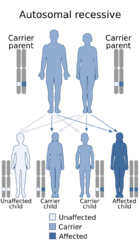Medicine:Norman–Roberts syndrome
| Norman–Roberts syndrome | |
|---|---|
| Other names | Microlissencephaly type A, Lissencephaly 2 |
 | |
| This condition is inherited in an autosomal recessive manner. | |
| Specialty | Neurology |
Norman–Roberts syndrome is a rare form of microlissencephaly caused by a mutation in the RELN gene.[1] A small number of cases have been described. The syndrome was first reported by Margaret Grace Norman and M. Roberts et al. in 1976.[2]
Lack of reelin prevents normal layering of the cerebral cortex and disrupts cognitive development. Patients have cerebellar hypoplasia, congenital lymphedema, and hypotonia. The disorder is also associated with myopia, nystagmus and generalized seizures.[citation needed]
Norman–Roberts syndrome is one of two known disorders caused by a disruption of the reelin-signaling pathway. The other is VLDLR-associated cerebellar hypoplasia, which is caused by a mutation in the gene coding for one of the reelin receptors, VLDLR.[citation needed]
Disruption of the RELN gene in human patients is analogous to the malfunctioning RELN gene in the reeler mouse.[citation needed]
References
- ↑ "Autosomal recessive lissencephaly with cerebellar hypoplasia is associated with human RELN mutations". Nature Genetics 26 (1): 93–96. 2000. doi:10.1038/79246. PMID 10973257.
- ↑ "Lissencephaly". Canadian Journal of Neurological Sciences 3 (1): 39–46. 1976. doi:10.1017/S0317167100025981. PMID 175907.
External links
| Classification |
|---|
 |

